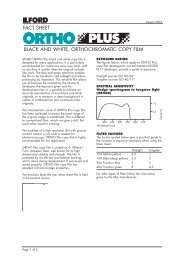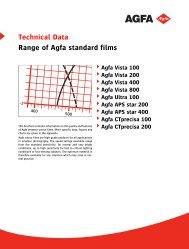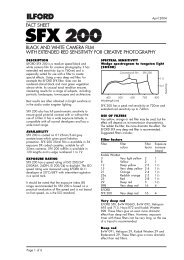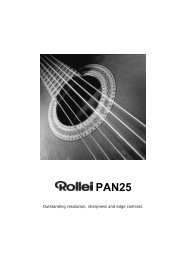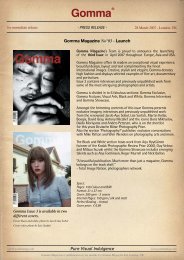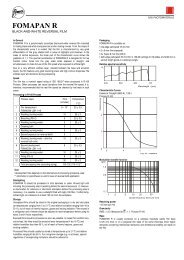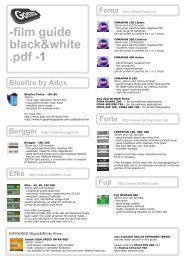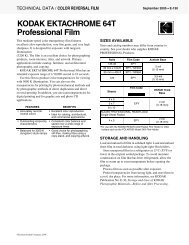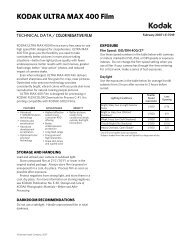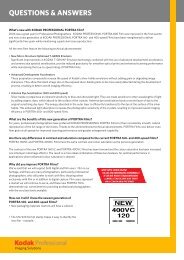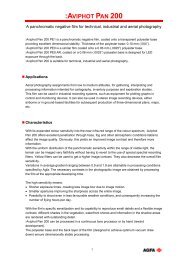Tech Pub F-4036 - Kodak
Tech Pub F-4036 - Kodak
Tech Pub F-4036 - Kodak
You also want an ePaper? Increase the reach of your titles
YUMPU automatically turns print PDFs into web optimized ePapers that Google loves.
TECHNICAL DATA / BLACK-AND-WHITE FILM<br />
January 2004 • F-<strong>4036</strong><br />
KODAK PROFESSIONAL BW400CN<br />
Film<br />
KODAK PROFESSIONAL BW400CN Film is a<br />
multi-purpose 400-speed black-and-white chromogenic film<br />
designed for processing in color negative chemistry and<br />
printing on color negative paper.<br />
BW400CN Film features the finest grain available today<br />
in a professional chromogenic film. The result is a smooth,<br />
neutral tone image with outstanding highlight and shadow<br />
detail.<br />
This film is designed for portrait/wedding, commercial<br />
and advanced amateur photographers looking for the power<br />
of black-and-white imagery coupled with the convenience of<br />
using Process C-41 for film and Process RA-4 for color<br />
prints.<br />
This film is intended for exposure with daylight,<br />
electronic flash, and artificial illumination. You can also<br />
obtain pleasing results under other light sources, i.e.<br />
illumination in stadiums, without using filters.<br />
Use KODAK FLEXICOLOR Chemicals for Process C-41<br />
and process this film simultaneously with color negative<br />
films. This film can be printed on KODAK<br />
PROFESSIONAL PORTRA ENDURA, SUPRA<br />
ENDURA, and ULTRA ENDURA Papers, as well as other<br />
color negative papers.<br />
Features<br />
• KODAK T-GRAIN®<br />
Emulsions<br />
• For processing in<br />
KODAK FLEXICOLOR<br />
Chemicals, Process<br />
C-41<br />
• Optimized for printing<br />
on color negative<br />
papers<br />
Benefits<br />
• Extremely fine grain and high<br />
sharpness<br />
• Excellent quality and detail in<br />
enlargements<br />
• Neutral, predictable results with a<br />
variety of printing devices<br />
• High quality film scans for ease of<br />
use in digital applications<br />
• Rapid turnaround in any lab that<br />
processes color negative film<br />
• Neutral-toned black-and-white<br />
prints from color processes<br />
• Smooth, neutral images with<br />
outstanding highlight and<br />
shadow detail<br />
SIZES AVAILABLE<br />
Catalog numbers and packaging may vary from country to<br />
country. See your dealer who supplies KODAK<br />
PROFESSIONAL Products.<br />
Size<br />
Base<br />
CAT No.<br />
(US &<br />
Canada)<br />
CAT No.<br />
(except<br />
US & C)<br />
135-24<br />
N/A 860 7640<br />
135-36<br />
0.13 mm (0.005 in)<br />
acetate<br />
897 6995 130 4740<br />
135-36 / 5 pk 183 3136 839 8075<br />
120 (single)<br />
N/A 126 5412<br />
120 / 5 pk<br />
0.10 mm (0.0039 in)<br />
acetate<br />
899 0558 873 9286<br />
220 / 5 pk 146 9717 N/A<br />
STORAGE AND HANDLING<br />
Before Exposure<br />
Load and unload your camera in subdued light.<br />
High temperatures or high humidity may produce<br />
unwanted quality changes. Store unexposed film at 21°C<br />
(70°F) or lower in the original package. Always store film<br />
(exposed or unexposed) in a cool, dry place. Though this<br />
film has excellent latent image keeping characteristics (after<br />
exposure, but before processing), for best results, process<br />
film as soon as possible after exposure.<br />
Protect processed film from strong light, and store it in a<br />
cool, dry place. For more information on storing negatives,<br />
see KODAK <strong>Pub</strong>lication No. E-30, Storage and Care of<br />
Photographic Materials—Before and After Processing.<br />
DARKROOM RECOMMENDATIONS<br />
Do not use a safelight. Handle unprocessed film in total<br />
darkness.<br />
©Eastman <strong>Kodak</strong> Company, 2004
EXPOSURE<br />
Daylight Exposure:<br />
Use the exposures in the table below for average frontlighted<br />
subjects from 2 hours after sunrise to 2 hours before sunset.<br />
Lighting Conditions<br />
* Use f/8 for backlighted close-up subjects.<br />
† Subject shaded from the sun but lighted by a large area of sky.<br />
Existing Light<br />
Shutter<br />
Speed<br />
(seconds)<br />
Lens Opening<br />
Bright/Hazy Sun on Light<br />
Sand or Snow 1/500 f/22<br />
Bright or Hazy Sun,<br />
Distinct Shadows 1/500 f/16 *<br />
Weak, Hazy Sun, Soft<br />
Shadows 1/500 f/11<br />
Cloudy Bright, No<br />
Shadows 1/500 f/8<br />
Heavy Overcast, Open<br />
Shade † 1/500 f/5.6<br />
Subject and Lighting<br />
Conditions<br />
Home Interiors at Night<br />
—Average Light<br />
—Bright Light<br />
Fireworks<br />
—Aerial Displays *<br />
—Displays on Ground<br />
Shutter Speed<br />
(second)<br />
1/30<br />
1/30<br />
"Bulb" or<br />
"Time" †<br />
1/60<br />
Lens Opening<br />
f/2<br />
f/2.8<br />
f/16<br />
f/4<br />
Interiors with Bright<br />
Fluorescent Light 1/60 ‡ f/4<br />
Brightly Lit Street Scenes<br />
at Night 1/60 f/2.8<br />
Neon and Other Lighted<br />
Signs 1/125 f/4<br />
Floodlighted Buildings,<br />
Fountains, Monuments 1/15 * f/2<br />
Night Football, Soccer,<br />
Baseball, Racetracks 1/125 f/2.8<br />
Basketball, Hockey,<br />
Bowling 1/125 f/2<br />
Stage Shows<br />
—Average Light<br />
—Bright Light<br />
Circuses and Ice Shows<br />
—Floodlighted Acts<br />
—Spotlighted Acts<br />
1/60<br />
1/125<br />
1/125<br />
1/250<br />
f2.8<br />
f/2.8<br />
School—State and<br />
Auditorium 1/30 f/2<br />
*Leave shutter open for several bursts.<br />
†Use a tripod or other firm camera support for exposure times longer than<br />
1/30 second.<br />
‡Use shutter speeds of 1/60 second or longer with fluorescent light.<br />
Electronic Flash<br />
Use the guide numbers in the table below as starting-point<br />
recommendations for your equipment. Select the unit output<br />
closest to the number given by your flash manufacturer.<br />
Then find the guide number for feet or metres.<br />
To determine the lens opening, divide the guide number<br />
by the flash-to-subject distance. If negatives are consistently<br />
too dense (overexposed), use a higher guide number; if they<br />
are too thin (underexposed), use a lower number.<br />
Unit Output<br />
(BCPS) *<br />
For Distances in<br />
Feet<br />
* BCPS = beam candlepower seconds<br />
Guide Number<br />
For Distances in<br />
Metres<br />
350 85 26<br />
500 100 30<br />
700 120 36<br />
1000 140 42<br />
1400 170 50<br />
2000 200 60<br />
2800 240 70<br />
4000 280 85<br />
5600 340 105<br />
8000 400 120<br />
Exposure Adjustments for Long and Short<br />
Exposures<br />
No exposure compensation for reciprocity failure is<br />
necessary for exposures between 1/10,000 and 120 seconds.<br />
We do not recommend exposures longer than 120 seconds.<br />
For critical applications, make tests under your conditions.<br />
Filter Factors<br />
Multiply the normal (unfiltered) exposure time by the filter<br />
factor.<br />
Daylight Tungsten<br />
KODAK WRATTEN Multiply Multiply<br />
Gelatin Filter Exposure By Exposure By<br />
(Filter Factor) (Filter Factor)<br />
No. 8 (yellow) 1.4 1.25<br />
No. 11 (yellowish Green) 3 3<br />
No. 15 (deep yellow) 2 1.4<br />
No. 25 (red) 8 3<br />
No. 47 (blue) 12.5 16<br />
No. 58 (green) 5.6 4<br />
Polarizing Filter * 2.5 2.5<br />
*Average filter factor, which may vary slightly depending on the<br />
manufacturer. Polarizing filters are not manufactured by <strong>Kodak</strong>.<br />
2 KODAK PROFESSIONAL BW400CN Film • F-<strong>4036</strong>
PROCESSING<br />
Process BW400CN Film in KODAK FLEXICOLOR<br />
Chemicals for Process C-41. You can have this film<br />
processed by any photofinisher who processes color negative<br />
films like KODAK PROFESSIONAL PORTRA Film.<br />
BW400CN Film is fully compatible with Process C-41, and<br />
can be intermixed with color negative films during<br />
processing in all equipment, from minilabs to high volume<br />
continuous, roller transport, or rack-and-tank processors.<br />
You can also use KODAK FLEXICOLOR Chemicals in<br />
the 1-gallon size to process this film in a small tank or a<br />
rotary-tube processor. For specifications on Process C-41,<br />
see <strong>Kodak</strong> <strong>Pub</strong>lication No. Z-131, Using KODAK<br />
FLEXICOLOR Chemicals.<br />
Important<br />
Do not process this film in conventional black-and-white<br />
chemicals.<br />
Negative Appearance<br />
The appearance of processed negatives on BW400CN Film<br />
is similar to color negative films, but with no color in the<br />
negative images.<br />
JUDGING NEGATIVE EXPOSURES<br />
You can check the exposure level of the processed negatives<br />
with a suitable electronic densitometer equipped with a filter<br />
such as the red filter for Status M Densitometry, or a<br />
KODAK WRATTEN Gelatin Filter No. 92. Depending on<br />
the subject and the light source used for exposure, a normally<br />
exposed color negative measured through the red filter<br />
should have the approximate densities listed below. These<br />
densities apply for the recommended light sources and<br />
correct processing of the negative.<br />
Densities of Properly Exposed and Processed<br />
Negatives:<br />
Area on the Negative:<br />
Densities:<br />
The KODAK Gray Card * (gray side) receiving<br />
the same illumination as the subject<br />
0.80 to 1.00<br />
The lightest step (darkest in the negative) of<br />
a KODAK Paper Gray Scale receiving the 1.15 to 1.35<br />
same illumination as the subject<br />
Normally lighted forehead of person with<br />
light complexion † 1.05 to 1.35<br />
Normally lighted forehead of person with<br />
dark complexion † 0.90 to 1.20<br />
* KODAK <strong>Pub</strong>lication No. R-27<br />
† Because of the extreme range in skin color, use these values only as a<br />
guide. For best results, use a KODAK Gray Card (gray side).<br />
RETOUCHING<br />
Treat the negative as if it were a color negative.<br />
You can retouch 120 / 220-size BW400CN Film on both<br />
the emulsion and base sides. 35 mm film can be retouched on<br />
the emulsion side only.<br />
Both retouching dye and black graphite lead pencil can be<br />
used to retouch this film. When retouching with pencil on the<br />
emulsion side, use KODAK Retouching Fluid to improve<br />
the tooth of the film.<br />
If you plan to use retouched BW400CN Film for printing<br />
on color negative paper, follow the Dye / Filter “Layering”<br />
<strong>Tech</strong>nique.<br />
For more information about retouching techniques,<br />
supplies, and equipment, see KODAK <strong>Pub</strong>lication E-71,<br />
Retouching Color Negatives.<br />
Dye / Filter Layering <strong>Tech</strong>nique<br />
To retouch small areas, use diluted KODAK Liquid<br />
Retouching Colors. For most retouching, you will need only<br />
two dyes: red-yellow and cyan. Prepare the diluted dyes<br />
according to the following formulas:<br />
Diluted<br />
Dyes<br />
Red-yellow<br />
Cyan<br />
Water:<br />
Formula Dilution 1 Dilution 2 Dilution 3<br />
5 drops<br />
red dye<br />
plus 1<br />
drop<br />
yellow dye<br />
plus<br />
distilled<br />
water<br />
3 drops<br />
cyan dye<br />
plus<br />
distilled<br />
water<br />
18 drops<br />
distilled<br />
water<br />
(1:3)<br />
15 drops<br />
distilled<br />
water<br />
(1:5)<br />
30 drops<br />
distilled<br />
water<br />
(1:5)<br />
30 drops<br />
distilled<br />
water<br />
(1:10)<br />
60 drops<br />
distilled<br />
water (1:10)<br />
60 drops<br />
distilled<br />
water (1:20)<br />
1. Hold a WRATTEN Gelatin Filter No. 58 (green) near<br />
your eye, and view the negative through the filter.<br />
Evaluate the areas to be retouched; if they appear<br />
lighter than the surrounding areas, apply red-yellow<br />
dye by using the technique described in step 2.<br />
2. Dip the brush into the dye, and stroke the tip on<br />
water-dampened cotton, tissue, or paper towel until the<br />
tip is almost dry. Smoothly apply a small amount of dye<br />
to the base side of the negative.<br />
Note: When you retouch along sharp edges in an image or<br />
make very fine corrections, apply dye to the emulsion side.<br />
This allows for more precise alignment of the retouching<br />
with the image and avoids parallax problems from inaccurate<br />
application.<br />
3. Hold a WRATTEN Gelatin Filter No. 25 (red) near<br />
your eye, and view the negative through the filter.<br />
Evaluate the areas to be retouched; if they appear<br />
lighter than the surrounding area, apply cyan dye by<br />
using the technique described in step 2.<br />
KODAK PROFESSIONAL BW400CN Film • F-<strong>4036</strong> 3
4. View the negative without using a filter. If a retouched<br />
area appears slightly red or slightly cyan, add a very<br />
small amount of the opposite-colored dye until the area<br />
appears neutral.<br />
After you have finished retouching and the negative is dry,<br />
sandwich the PORTRA 400BW negative with a piece of<br />
unexposed and processed D-min of another color negative<br />
film, such as KODAK PROFESSIONAL PORTRA 160VC<br />
Film. Although you can print it onto color paper without the<br />
"extra D-min," this may make it easier to print on color<br />
paper.<br />
For more information about retouching techniques,<br />
supplies, and equipment, see KODAK <strong>Pub</strong>lication E-71,<br />
Retouching Color Negatives.<br />
PRINTING NEGATIVES<br />
Note: BW400CN Film is optimized for printing on color<br />
negative papers. BW400CN Film can be printed on<br />
traditional black-and-white papers, but the printing time will<br />
be substantially longer and require a higher contrast grade of<br />
paper (3.5 to 4). For best results when printing onto<br />
black-and-white paper, we recommend a traditional<br />
black-and-white film such as KODAK PROFESSIONAL<br />
TRI-X 400 or T-MAX 100 Film.<br />
BW400CN Film is designed to deliver excellent<br />
black-and-white prints on professional color papers. When<br />
printing on color papers, you can also create special-effect<br />
tones, such as sepia, simply by changing the printer color<br />
balance.<br />
You can make black-and-white prints from BW400CN<br />
Film negatives by enlarging them on KODAK<br />
PROFESSIONAL PORTRA ENDURA, SUPRA ENDURA<br />
and ULTRA ENDURA Papers, KODAK PROFESSIONAL<br />
DURAFLEX Plus Digital Display Material, KODAK<br />
PROFESSIONAL ENDURA Metallic Paper, and KODAK<br />
PROFESSIONAL PORTRA Black & White Paper for<br />
Process RA-4. For a sepia-tone print, try KODAK<br />
PROFESSIONAL PORTRA Sepia Black & White Paper.<br />
Make color slides and transparencies by printing the<br />
negatives on KODAK PROFESSIONAL ENDURA<br />
Transparency Display Material or KODAK<br />
PROFESSIONAL ENDURA Clear Display Material.<br />
Starting Printing Filter Pack<br />
When working with a color enlarger to print on professional<br />
color papers and display materials, add 5M to your KODAK<br />
PROFESSIONAL PORTRA 160NC Film filter balance, and<br />
make adjustments to balance the print to a desired tone.<br />
Digital Files<br />
You can scan your image to a file and print digitally to —<br />
KODAK PROFESSIONAL PORTRA ENDURA Paper<br />
KODAK PROFESSIONAL SUPRA ENDURA Paper<br />
KODAK PROFESSIONAL ULTRA ENDURA Paper<br />
KODAK PROFESSIONAL ENDURA Transparency<br />
Display Material<br />
KODAK PROFESSIONAL ENDURA Clear Display<br />
Material<br />
KODAK PROFESSIONAL DURAFLEX Plus Digital<br />
Display Material<br />
KODAK PROFESSIONAL ENDURA Day/Night<br />
Display Material<br />
KODAK PROFESSIONAL ENDURA Metallic Paper<br />
4 KODAK PROFESSIONAL BW400CN Film • F-<strong>4036</strong>
IMAGE STRUCTURE<br />
Sharpness: Extremely high<br />
Degree of Enlargement: Extremely high<br />
CURVES<br />
Characteristic Curve<br />
Print Grain Index Magnification Table:<br />
Print Grain Index numbers for diffuse printing illumination.<br />
• This is a method which replaces rms granularity. It is on<br />
a different scale, which cannot be compared to rms<br />
granularity.<br />
• The scale is a uniform perceptual scale, with a change of<br />
4 units representing a Just Noticeable Difference for<br />
90% of observers.<br />
• Index value representing the approximate visual<br />
threshold for graininess: 25.<br />
• Standardized inspection distance for all print sizes: 35.6<br />
cm (14 inches).<br />
• In practice, prints larger than 10.2 x 15.2 cm (4x6<br />
inches) will likely be viewed from distances greater than<br />
35.6 cm (14 inches), thereby reducing overall graininess<br />
that is perceived.<br />
• These Grain Index numbers may not represent<br />
graininess observed from more specular printing<br />
illuminants, such as condenser enlargers.<br />
Negative Size: 24 x 36 mm (Size 135)<br />
Print Size in inches 4x6 8x10 16x20<br />
Magnification 4.4X 8.8X 17.8X<br />
Print Grain Index less than 25 40 70<br />
Negative Size: 6 x 6 cm (Size 120/220)<br />
Print Size in inches 4x6 8x10 16x20<br />
Magnification 2.6X 4.4X 8.8X<br />
Print Grain Index less than 25 less than 25 40<br />
LOG SENSITIVITY*<br />
DENSITY<br />
4.0<br />
3.0<br />
2.0<br />
1.0<br />
Exposure: Daylight<br />
Densitometry: Status M<br />
Log H Ref: -1.44<br />
0.0<br />
-4.0 -3.0 -2.0 -1.0 0.0 1.0<br />
F009_0274AC LOG EXPOSURE (lux-seconds)<br />
4.0<br />
3.0<br />
2.0<br />
1.0<br />
Spectral-Sensitivity Curve<br />
Effective Exposure: 1/100 Sec<br />
Process: C-41<br />
Densitometry: Status M<br />
Density: 0.2 above D-min<br />
B<br />
G<br />
R<br />
0.0<br />
250 300 350 400 450 500 550 600 650 700 750<br />
WAVELENGTH (nm)<br />
F009_0275AC<br />
*Sensitivity = reciprocal of exposure (erg/cm ) required<br />
to produce specified density<br />
2<br />
NOTICE: The sensitometric curves and data in this<br />
publication represent product tested under the conditions of<br />
exposure and processing specified. They are representative<br />
of production coatings, and therefore do not apply directly to<br />
a particular box or roll of photographic material. They do not<br />
represent standards or specifications that must be met by<br />
Eastman <strong>Kodak</strong> Company. The company reserves the right<br />
to change and improve product characteristics at any time.<br />
KODAK PROFESSIONAL BW400CN Film • F-<strong>4036</strong> 5
KODAK PROFESSIONAL BW400CN Film<br />
RESPONSE (%)<br />
DIFFUSE SPECTRAL DENSITY<br />
2.5<br />
2.0<br />
1.5<br />
1.0<br />
0.5<br />
Spectral-Dye-Density Curves<br />
Typical densities for a midscale neutral subject<br />
and D-min.<br />
Minimum Density<br />
Midscale Density<br />
0.0<br />
400 450 500 550 600 650 700<br />
F009_0576AC<br />
200<br />
100<br />
70<br />
50<br />
30<br />
20<br />
10<br />
7<br />
5<br />
3<br />
2<br />
WAVELENGTH (nm)<br />
Modulation Transfer Function<br />
Exposure: Daylight<br />
Process: C-41<br />
1<br />
1 2 3 4 5 10 20 50 100 200 600<br />
SPATIAL FREQUENCY (cycles/mm)<br />
F009_0577AC<br />
B<br />
G<br />
R<br />
MORE INFORMATION<br />
<strong>Kodak</strong> has many publications to assist you with information<br />
on <strong>Kodak</strong> products, equipment, and materials.<br />
The following publications are available from <strong>Kodak</strong><br />
Customer Service, from dealers who sell <strong>Kodak</strong> products, or<br />
you can contact <strong>Kodak</strong> in your country for more information.<br />
E-30 Storage and Care of KODAK Photographic<br />
Materials—Before and After Processing<br />
E-58 Print Grain Index<br />
E-71 Retouching Color Negatives<br />
E-4021 KODAK PROFESSIONAL PORTRA and SUPRA<br />
ENDURA Papers<br />
E-4020 KODAK PROFESSIONAL ULTRA ENDURA<br />
Paper<br />
E-4031 KODAK PROFESSIONAL ENDURA<br />
Transparency and Clear Display Materials<br />
E-4028 KODAK PROFESSIONAL ENDURA Metallic<br />
Paper<br />
E-4034 KODAK PROFESSIONAL ENDURA Day/Night<br />
Display Material<br />
G-4006 KODAK PROFESSIONAL PORTRA Black &<br />
White Paper<br />
E-4019 KODAK PROFESSIONAL PORTRA Sepia Black<br />
& White Paper<br />
J-38 Using KODAK FLEXICOLOR Chemicals in<br />
Sink-Line, Bath, and Rotary-Tube Processors<br />
Z-131 Using KODAK FLEXICOLOR Chemicals<br />
For the latest version of technical support publications for<br />
KODAK PROFESSIONAL Products, visit <strong>Kodak</strong> on-line at:<br />
http://www.kodak.com/go/professional<br />
If you have questions about KODAK PROFESSIONAL<br />
Products, call <strong>Kodak</strong>.<br />
In the U.S.A.:<br />
1-800-242-2424, Ext. 19, Monday–Friday<br />
9 a.m.–7 p.m. (Eastern time)<br />
In Canada:<br />
1-800-465-6325, Monday–Friday<br />
8 a.m.–5 p.m. (Eastern time)<br />
Note: The <strong>Kodak</strong> materials described in this publication for<br />
use with KODAK PROFESSIONAL BW400CN Film are<br />
available from dealers who supply KODAK<br />
PROFESSIONAL Products. You can use other materials,<br />
but you may not obtain similar results.<br />
EASTMAN KODAK COMPANY<br />
KODAK PROFESSIONAL<br />
BW400CN Film<br />
KODAK <strong>Pub</strong>lication No. F-<strong>4036</strong><br />
<strong>Kodak</strong>, <strong>Kodak</strong> Professional, Duraflex, Endura, Flexicolor, Panalure, Portra, Supra,<br />
T-Grain, T-Max, Tri-X, Ultra, and Wratten are trademarks.<br />
New 1-04<br />
Printed in U.S.A.




